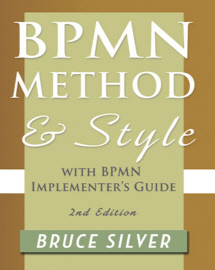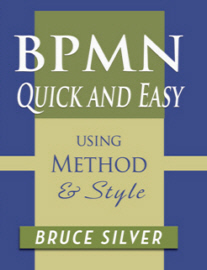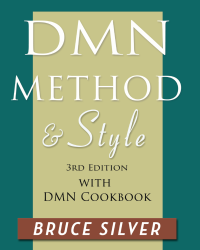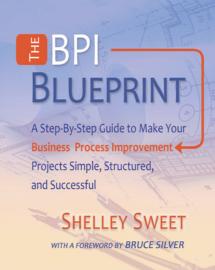 BPMN Method and Style is the authoritative source on process modeling with the BPMN 2.0 standard. The first half of the book is addressed to process modelers – business process analysts, business architects, BPM project team members, as well as developers – and focuses on the graphical notation. It explains Method and Style’s driving principle – that the process logic should be described unambiguously, completely, and consistently from the diagram alone – and presents a methodology and style rules to achieve it. Based on years of experience of delivering BPMN Method and Style training, the book is now available in German, Spanish, and Japanese editions. More info on the book…
BPMN Method and Style is the authoritative source on process modeling with the BPMN 2.0 standard. The first half of the book is addressed to process modelers – business process analysts, business architects, BPM project team members, as well as developers – and focuses on the graphical notation. It explains Method and Style’s driving principle – that the process logic should be described unambiguously, completely, and consistently from the diagram alone – and presents a methodology and style rules to achieve it. Based on years of experience of delivering BPMN Method and Style training, the book is now available in German, Spanish, and Japanese editions. More info on the book…
The book explains how fundamental BPMN concepts like “activity” and “process” differ from those terms as used in BPM Architecture and associated business process frameworks. It shows how BPMN style, described in the first edition as “best practices”, is more effectively implemented as a set of rules that are validated in a BPMN tool. It continues the levels-based approach of the first edition – Level 1 being a basic working set of shapes and symbols familiar to business people from traditional flowcharting, and Level 2 a somewhat expanded set supporting event-triggered behavior – but makes slight adjustments to each level to match the Descriptive (Level 1) and Analytic (Level 2) Process Modeling Conformance subclasses in the final BPMN 2.0 spec.
The second half of the book, the BPMN Implementer’s Guide, is primarily addressed to developers and tool vendors, although analysts and architects will benefit from it as well. It explains the BPMN 2.0 metamodel and XML serialization. The first part of the BPMN Implementer’s Guide focuses on non-executable models using elements of the Analytic subclass (Level 2 palette) only, explaining the meaning and usage of the various XML elements and attributes. The second part discusses executable BPMN 2.0 and the serialization of data mapping, service tasks, human task assignment, and similar details. It presents an example using Bonita Open Solution to illustrate the relationship between executable design in a real BPM Suite and its representation in the BPMN 2.0 export. It concludes with recommendations to implementers for aligning executable BPMN 2.0 with Method and Style. The BPMN Implementer’s Guide is logically a separate book, but a number of its ideas flow naturally from Method and Style, so the simplest thing was to combine them.
 Where BPMN Method and Style 2nd Edition was a comprehensive reference, BPMN Quick and Easy is slimmed down, focusing on just the elements today’s process modelers need to know. Based on the experience of delivering Method and Style training to thousands of students, it explains in business-friendly form the BPMN vocabulary, methodology, and the style rules. It makes creating Good BPMN – models that reveal the process logic clearly and completely from the printed diagrams alone – as streamlined and “mechanical” as possible.
Where BPMN Method and Style 2nd Edition was a comprehensive reference, BPMN Quick and Easy is slimmed down, focusing on just the elements today’s process modelers need to know. Based on the experience of delivering Method and Style training to thousands of students, it explains in business-friendly form the BPMN vocabulary, methodology, and the style rules. It makes creating Good BPMN – models that reveal the process logic clearly and completely from the printed diagrams alone – as streamlined and “mechanical” as possible.

DMN is the standard for model-based decision automation. Using standardized diagrams and tables together with the Low-Code expression language FEEL, DMN empowers both business and technical users to decompose complex decision logic into transparent and easily maintained models that can be instantly deployed as executable REST services. DMN Method and Style 3rd Edition is completely revised from the 2nd edition and updated to the draft DMN 1.6 specification. Part I is the business-oriented Guide to Decision Modeling, explaining the creation and use of Decision Requirements Diagrams, decision tables, and all the tabular boxed expression types, as well as a deep dive into all the FEEL functions and operators. Part II is the more technically oriented DMN Cookbook, updated to DMN 1.5/1.6, with solutions to over 40 modeling challenges.
 The BPI Blueprint provides you with a detailed plan of action to create results the first time, inspire leaders of business processes, and build invigorated skilled teams. So if you’re looking for a simple, no nonsense, guide to help you develop and manage effective Business Process Improvement projects, regardless of your experience-level, you’ve got the right book.
The BPI Blueprint provides you with a detailed plan of action to create results the first time, inspire leaders of business processes, and build invigorated skilled teams. So if you’re looking for a simple, no nonsense, guide to help you develop and manage effective Business Process Improvement projects, regardless of your experience-level, you’ve got the right book.

